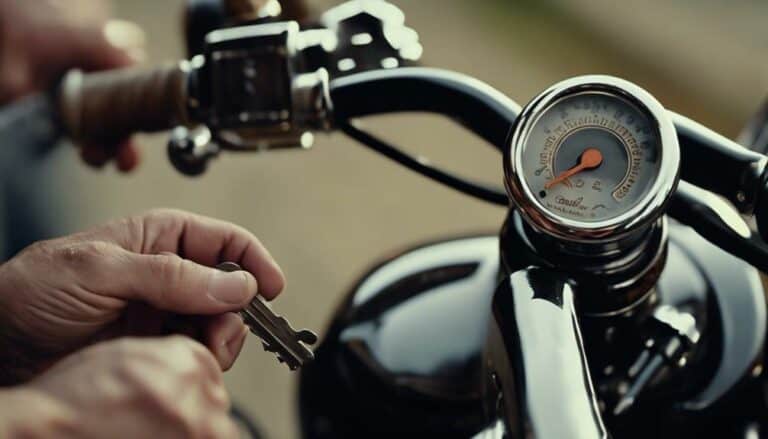Starting a carbureted Harley Davidson may seem like a daunting task, but with the right steps, it becomes a straightforward process.
Ensuring your fuel valve is open and adjusting the choke properly are crucial initial steps. However, the real secret lies in the ignition and choke setup. Once you've mastered this, the engine will be ready to roar to life.
Stay tuned for the next steps to smoothly transition from startup to hitting the road on your classic Harley.
Key Takeaways
- Perform pre-ride inspection for safety and functionality.
- Ensure fuel system readiness and proper carburetor setup.
- Start the engine with correct fuel-air mixture adjustment.
- Warm up the engine and ride smoothly for optimal performance.
Pre-Ride Inspection
Before starting a carbureted Harley Davidson, it's crucial to conduct a thorough pre-ride inspection to ensure the motorcycle is in optimal condition for safe operation.
Begin by visually inspecting the bike for any signs of damage or leaks. Check the oil level and quality to guarantee proper lubrication of the engine components.
Ensuring the tires are properly inflated and have adequate tread depth is vital for stability and traction on the road. Test the brakes to confirm they're functioning correctly, providing you with the necessary stopping power when needed.
Additionally, inspect the lights, signals, and horn to guarantee they're in working order, enhancing your visibility to other motorists on the road.
These maintenance tips are essential for your safety on the road, as they help prevent potential mechanical failures that could lead to accidents. By incorporating these safety precautions into your pre-ride routine, you can enjoy your ride with peace of mind.
Fuel System Check
Inspect the fuel valve on your carbureted Harley Davidson to ensure it's open for proper fuel flow before starting the motorcycle. This step is crucial to provide the engine with the necessary fuel for ignition and smooth operation. Additionally, verify that the fuel tank has an adequate amount of fuel to support the startup process without any interruptions.
Furthermore, it's essential to check the fuel lines for any signs of damage or blockages that could impede the flow of fuel to the carburetor. Any obstructions or leaks in the fuel system can lead to starting issues or poor performance while riding. Ensuring the cleanliness of the carburetor is also vital; debris or dirt accumulation can disrupt the fuel mixture, affecting the motorcycle's performance.
Consider using a fuel stabilizer if you plan to store your carbureted Harley Davidson for an extended period. Fuel stabilizers help prevent fuel degradation and maintain the proper functioning of the fuel system, reducing the risk of issues when you're ready to ride again.
Ignition and Choke Setup
Ensure that the ignition key is turned to the 'on' position to prepare for starting your carbureted Harley Davidson efficiently. Proper ignition is crucial for the engine to receive the necessary spark for combustion.
Additionally, understanding the choke setup is essential. The choke should be adjusted based on the temperature to achieve the correct air-fuel mixture for starting. Cold weather adjustments are particularly important as they help enrich the fuel mixture, making cold starts smoother.
Carburetor tuning plays a significant role in ensuring the engine runs smoothly. A well-tuned carburetor will provide the right amount of fuel to mix with the incoming air.
Ignition and choke systems must be in good condition to facilitate easy starting of the Harley Davidson. By paying attention to these details, you can optimize the starting process and enjoy a seamless riding experience.
Starting the Engine
To initiate the engine on your carbureted Harley Davidson, follow these steps for a smooth start:
- Turn on the fuel valve: Ensure the fuel valve is in the 'on' position to allow fuel to flow to the carburetor for combustion.
- Adjust the choke: Set the choke according to the manufacturer's guidelines. For cold starts, enriching the air-fuel mixture with the choke aids in ignition.
- Prime the engine: Give a few throttle twists before starting the engine. This action draws fuel into the carburetor, facilitating the combustion process.
- Start the engine: With the choke adjusted and the engine primed, start the Harley Davidson by engaging the starter. Monitor the engine and adjust the choke as necessary for a stable idle.
Warm-Up and Ride
Upon starting a carbureted Harley Davidson, it's essential to allow the engine to warm up for optimal performance and longevity. Engine temperature plays a crucial role in the overall functionality of the motorcycle. It's recommended to let the engine idle for a few minutes to reach the appropriate operating temperature. During this warm-up period, it's beneficial to ride the motorcycle at a moderate speed to help distribute oil throughout the engine and warm up the tires. This practice ensures that all components are properly lubricated and ready for operation.
Avoid excessive idling during warm-up, as this can lead to carbon buildup in the engine, affecting its efficiency and longevity. Once the engine has reached the desired temperature, you can proceed to ride the motorcycle smoothly. Riding at a steady pace not only enhances performance but also contributes to better fuel efficiency and maintenance of the motorcycle. By following these warm-up and riding practices, you can enjoy a smoother and more reliable riding experience on your carbureted Harley Davidson.
Conclusion
In conclusion, starting a carbureted Harley Davidson requires attention to detail and precision. By following the proper steps of turning on the fuel valve, adjusting the choke, priming the engine, and starting up correctly, you can ensure a smooth start and a great ride.
Remember, while the process may seem complex at first, with practice, it becomes second nature, allowing you to enjoy the classic experience of riding a carbureted Harley Davidson.
So, gear up and hit the road!

